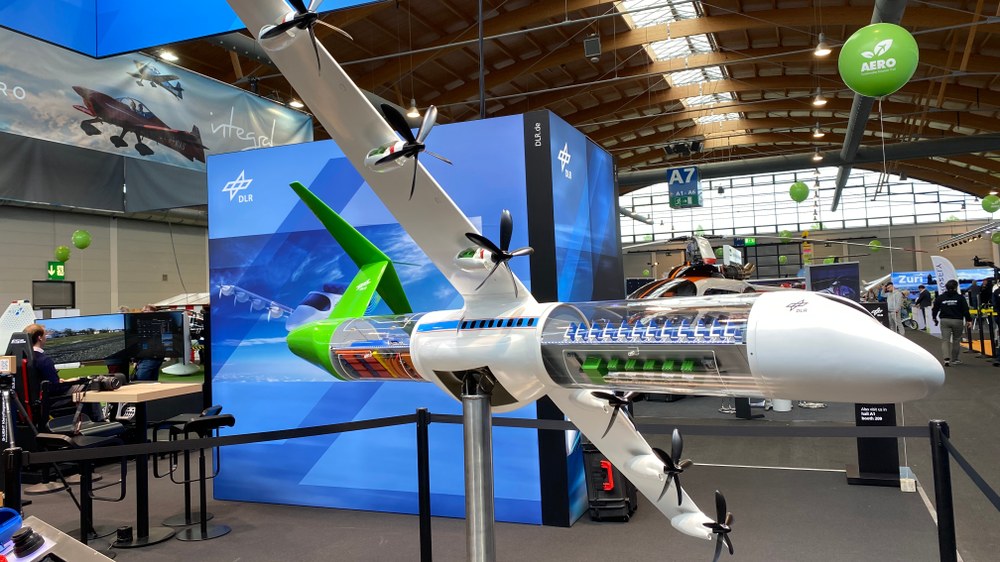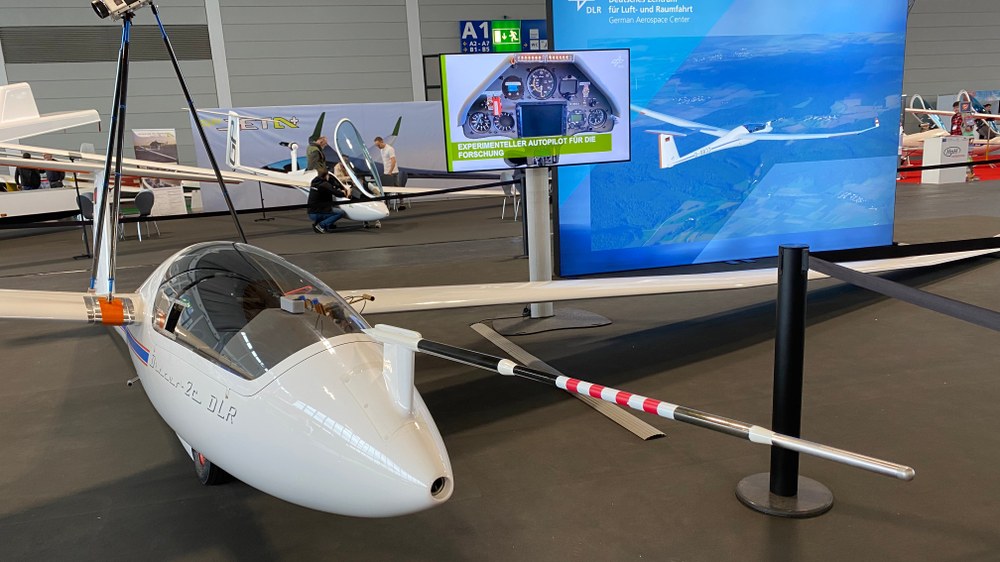DLR research at AERO 2024


- DLR will have an expanded presence at the anniversary edition of AERO Friedrichshafen.
- The focus will be on concepts and models for climate-friendly regional aircraft, as well as a unique research platform for the development of small aircraft.
- General aviation has a special role to play as a pioneer in the introduction of climate-friendly aviation technologies.
- Focus: Aeronautics, climate-friendly flight
AERO Friedrichshafen is the leading international trade show for general aviation, business aviation and air sports. In its anniversary year of 2024, the show will open its doors for the 30th time from 17 to 20 April. The German Aerospace Center (Deutsches Zentrum für Luft- und Raumfahrt; DLR) will be there. This year’s focus will be on climate-friendly flight (Hall A7, Stand 201) with exhibits ranging from a concept for a nine-seater short-haul aircraft to a 50-seat electric aircraft for regional air transport. Hydrogen fuel cell propulsion is a technological focus of all these aircraft. The Discus-2c DLR, a unique research platform for small aircraft, will also be on display at the show (Hall A1, Stand 209).
"Electric propulsion systems with batteries and, in particular, fuel cells and hydrogen as energy sources will play a key role for small and regional aircraft in the future," says Markus Fischer, DLR Divisional Board Member for Aeronautics. "At AERO 2024, we will be showcasing examples of our research that are driving the development of climate-friendly aviation from small to large aircraft, in line with DLR's aviation strategy."
It is comparatively easy to introduce and test sustainable propulsion systems and concepts on shorter routes with fewer passengers, so that they can then be used more widely in the future. DLR is therefore increasingly involved in the research, development and testing of climate-friendly small and regional aircraft. Two DLR facilities established in recent years – the Cottbus Institute of Electrified Aero Engines and the Small Aircraft Technology facility, with an interdisciplinary innovation centre in the Aachen region – are conducting research in this area and will be represented at the trade fair.
DLR's presence at AERO 2024 will focus in particular on these exhibits and topics:
Discus-2c DLR – research platform for small aircraft
Discus-2c DLR heralds a new era in small aircraft research in almost every way. Based on a widely-used high-performance glider with an 18-metre wingspan, it is built predominantly of carbon fibre reinforced plastic (CFRP). This pioneering research glider, unique in Europe, extends its investigations well beyond mere aerodynamics, delving into areas such as flight mechanics, aeroelasticity, measurement technology, human-machine interaction and certification. Within the field of digitalisation research, the Discus-2c DLR serves as a prototype for the development of and research into a digital twin. Moreover, it acts as a benchmark aircraft for evaluating the performance of emerging glider models. Forty-eight strain gauges are located on the fuselage and wings, meticulously measuring the loads across various flight conditions. Another 22 measuring points equipped with fibre Bragg grating deliver highly precise measurements of structural deflection. The Discus also has magnetic field probes and acceleration sensors at various points on the structure, sensors on all of the control surfaces, an inertial measurement unit in the fuselage, and a nose boom with a probe to detect flow angles and speeds. There is ample space within the aircraft's fuselage to accommodate additional extensive measurement technology in a dedicated storage compartment.

D-LIGHT – climate-neutral light aircraft
Due to their great versatility, small aircraft are used worldwide for various tasks, such as feeder flights, medical missions or supplying remote regions. One promising avenue for ensuring the environmental friendliness of these aircraft in the future involves employing an electric fuel cell drive powered by climate-neutral hydrogen. As part of the D-LIGHT (Digital Climate Neutral Light Aircraft) project, DLR is developing new methods for designing a hydrogen aircraft with an electric fuel cell drive. Researchers are investigating and modelling technology modules and processes across various disciplines and integrating them within a digital design environment. This approach facilitates automated concept development and expedites the design process. The tools under development will be harnessed to craft a hydrogen-powered small aircraft with nine seats, alongside creating a detailed digital mock-up. This innovative aircraft concept will be showcased in a flight simulator at AERO 2024, offering attendees a first-hand experience.

H2ELECTRA – aviation propulsion concepts for future regional aircraft
DLR is using the H2ELECTRA model to illustrate how aircraft of up to 50 seats might fly on electric or hybrid-electric power using hydrogen and fuel cells. Featuring interchangeable components, the model facilitates visualisation of various drive architectures, innovative technologies and integration concepts. The 1:10 scale model, with a wingspan of nearly three metres, embodies the Institute's integrated system approach and diverse electrification strategies for future regional aircraft. At AERO 2024, a variant featuring a fuselage-integrated powertrain with all critical components will be showcased at the DLR stand. This demonstration underscores technological possibilities and future prospects for aviation while addresses current key topics of electric flying, its potential and challenges.

Airfox – design and simulation tool for fuel cell systems
The Airfox software tool serves to design and simulate fuel cell systems in aviatio. It draws primarily upon experimental data derived from stack tests conducted at DLR, complemented by modelling auxiliary systems at varying degrees of complexity. This comprehensive model enables the assessment of system behaviour through all stages of a flight mission, with the ultimate goal of guiding the formulation of an overall system design. Visitors to the DLR stand can input aircraft specifications, and Airfox will define an appropriate fuel cell system.
Additionally, DLR will be participating in the AERO Hydrogen & Battery Summit and the 'Infrastructures of the future for airfields and airports' conference.
